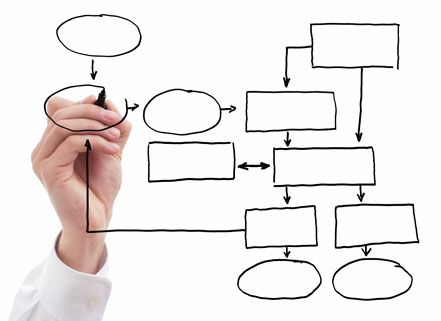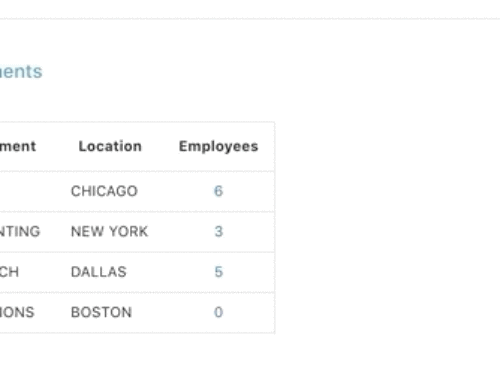
A client of mine wanted me to build an online form using Oracle APEX that, while fairly simple in design, had a fairly complicated workflow associated with it.
Each document had to flow through many different approval levels, and at each point, the possible actions a user could take would differ.
At first glance I thought I’d just manually create a lot of different buttons on the page and use various authorization schemes to display or hide them depending on document status and user role. I did not look forward to this task, considered the likeliness of the workflow changing (high!), and thought there must be a better way.
What I ended up doing was translating the workflow into table form based on the current document status.
TBL_STATUS_WORKFLOW
ID number;
CURRENT_STATUS number;
NEXT_POSSIBLE_STATUS number;
Both CURRENT_STATUS and NEXT_POSSIBLE_STATUS are foreign keys to a TBL_STATUS table, that looks like this:
TBL_STATUS
STATUS_ID number;
STATUS_DESCRIPTION varchar2;
BUTTON_REQUEST varchar2;
BUTTON_LABEL varchar2;
Say, for example, my document is in DRAFT mode (status). My workflow says that a document that is still in ‘Draft’ can go either to ‘Submitted to Level 1’ status or ‘Withdrawn’. Ideally, at this point, I would like to display 2 buttons to my user: ‘Submit to Level 1’ that would trigger a status change and email to appropriate party, and ‘Withdraw’, which would also trigger a status change.
My tables look something like this (small sample only):
TBL_STATUS
| STATUS_ID | STATUS_DESCRIPTION | BUTTON_REQUEST | BUTTON_LABEL |
|---|---|---|---|
| 1 | Draft | ||
| 2 | Submitted to Level 1 | SUBMIT_LVL_1 | Submit to Level 1 |
| 3 | Withdrawn | WITHDRAW | Withdraw |
| 4 | Submitted to Level 2 | SUBMIT_LVL_2 | Submit to Level 2 |
| 5 | Returned for revisions | RETURN_REV | Return for Revisions |
To translate my workflow and indicate that the document can move from Draft to either Submitted to Level 1 or Withdrawn, my TBL_STATUS WORKFLOW looks like this:
| ID | CURRENT_STATUS | NEXT_POSSIBLE_STATUS |
|---|---|---|
| 1 | 1 | 2 |
| 2 | 1 | 3 |
Obviously, this table is a lot bigger, as I stored all the possible outcomes for each of 12 different statuses. Otherwise, obviously, I would have gone the manual button route!!
How do I display my buttons on my APEX page now? By creating a PL/SQL Dynamic Content region that looks something like this:
declare
Begin
for c in (select s.status_id, button_request, button_label
from tbl_status_workflow sw, tbl_status s
where sw.current_status=:P5_STATUS and sw.next_possible_status=s.status_id) loop
if pkg_workflow.should_display_button(:P_USER_ID,c.status_id) then
htp.p(‘<button value=”‘||c.button_label||'” onclick=”apex.submit(”’||c.button_request||”’);” class=”button-gray” type=”button”>
<span>’||c.button_label||'</span>
</button>’);
end if;
end loop;
end;
Whether or not I displayed a button to a user not only depended on the document’s current status, but also to the user’s role, hence the pkg_workflow.should_display_button call.
I also created an After Submit process on the page that was simply the following:
begin
pkg_workflow.change_status(:P5_DOCUMENT_ID,:REQUEST);
pkg_workflow.notify_parties(:P5_DOCUMENT_ID,:REQUEST);
end;
Both of these take the value of the button’s request and the document’s id and process it accordingly. The first one simply changes the document’s status (and therefore automatically displaying a new series of buttons in the Dynamic PL/SQL region based on the TBL_STATUS_WORKFLOW table, cool!), and the second fires off any emails that are required by the workflow.
Obviously there are a few other tables involved (I also created a table of email templates for the email notifications, that were linked to the new status of the document), as well as a table that identified which buttons should display for which user role (used by the pkg_workflow.should_display_button function).
But basically, being able to dynamically generate the buttons using the Dynamic PL/SQL region, instead of creating them manually and adding a bunch of authorization schemes, I saved myself a ton of work!
How have you implemented workflow requirements into your APEX apps? I’d love to hear from you!







Love it. Seeing as the workflow (package) creates the buttons, the user now has the possibility to change the workflow. You don’t have to go into the pages and edit authorizations.
Simple yet effective.
Love it.
“Simplicity is the ultimate sophistication.” – Leonard da Vinci
[…] I was recently asked to implement a fairly large and complicated form in APEX. Rather than displaying something long and scary to users on a single page, we decided to break it out into sections on different pages, and use a Sidebar Navigation Region that would show the user which section he/she was currently filling out, and where in the process he/she was, as in the example below. By the way, this also happened to be the same form in which I implemented a simple yet powerful workflow using Dynamic PL/SQL. […]
Thanks so much for taking the time to talk to me. I appreciated your advise.
Very good Logic. Thanks for sharing the same.
Excellent !
Very good sample.
Thanks for sharing.
I’m testing it …
Beautiful – simple and elegant. And since the button creation is data driven, highly flexible too!
Thanks Rick! I have used this concept time and time again, it has been a huge time saver and allows for great flexibility when workflow changes.